A night in Jeonju
Jeonju Hanok Village provides a unique experience in the middle of a modern city. / Photo by Elias Arturo Molina
By Elias Arturo Molina
This is an article written by a foreign student participating in the "Must-See Routes" program organized by the Visit Korea Committee. It is the first of a three-part series of articles in The Korea Times' tourism section — ED.
"Have you been to Jeonju?" A Korean friend of mine asked me one day.
I thought I knew quite a lot about Korea, but I had never been to the city of Jeonju, North Jeolla Province, although I knew it was famous for its culture and history.
Swept up in a wave of curiosity, I hopped on a bus heading to Jeonju one evening. About three hours after leaving Seoul, I was finally in the mid-western city.
Hanok experience
At first sight, Jeonju felt different from other Korean cities I visited. It seemed to be a place where the past coexisted in harmony with the present.
There were alleyways full of traditional "hanok" houses, distinguished by their low roofs ornamented with exquisitely-designed tiles.
Hanok are houses built in the traditional architectural style of Korea where the columns, rafters, doors and floors are made with wood and the walls are constructed with earth and straw.
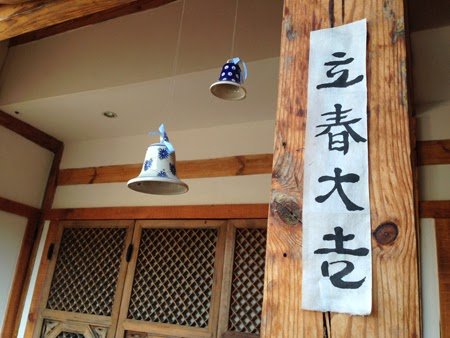
The ceiling of the hanok that I stayed in,and the interior of the room inside a hanok house represents the classic styles of Korean architecture.
The windows are plastered with handmade traditional paper called "hanji" and the roofs are covered with bluish-black tiles that form an upward curve.
Jeonju Hanok Village is comprised of 700 traditional houses and offers visitors opportunities to experience living inside a hanok. The hanok experience includes traditional tea-drinking, "bibimbap" (rice mixed with red pepper paste, sesame oil, meat and vegetables) meals and an overnight stay.
I stayed at a guesthouse called "Sieundang," which means "a space hidden inside the city," located inside the hanok village. The name of the guesthouse reflected the atmosphere of the hanok village, which retained its quietness amid the bustling cityscape.
As I sipped a cup of traditional tea inside my guesthouse, looking up at the full moon, I felt as if time had stopped.
The hanok lifestyle experience center located in the village consists of a men's lodging house that is separated from the main building by a hall. An overnight stay that includes breakfast costs between 70,000 won and 130,000 won for two people.
Those traveling in groups can register for programs that provide traditional Korean buffets and musical performances.
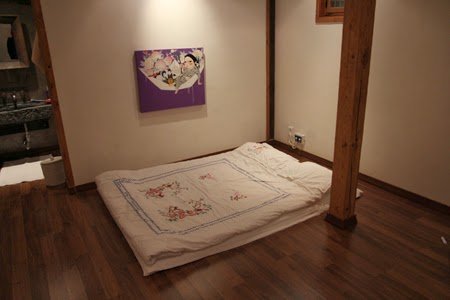
Traditional Korean houses had floors which were heated. Koreans used to sleep on the floor on thick mattresses like the one in the photo.
Tasty Jeonju
Morning at the hanok village was busy and bustling. Shops were busy opening for business, while early-bird travelers started discovering its hidden corners one by one.
Jeonju has many attractions, one of the most important of which is food. Jeonju food is diverse and served in generous portions. It's no wonder that people travel to Jeonju just to taste its food.
Kongnamul gukbab
My breakfast in Jeonju started with a Jeonju specialty, "kongnamul gukbab," which translates as "bean sprout soup with rice."
Unlike the other "gukbab" elsewhere in Korea, Jeonju gukbab does not include eggs in the soup.
In addition, the bean sprout soup here isn't cooked to boiling point, so the bean sprouts retain their crunchiness. The gukbab is eaten by putting three to four spoons of the soup into a separate bowl of "suran" (soft boiled eggs) and mixing it with seaweed strips.
The taste of the dish is magnified when accompanied by "moju," a beverage created by brewing eight herbal ingredients including ginger, dates and cinnamon with the "makgeolli" peasant wine.
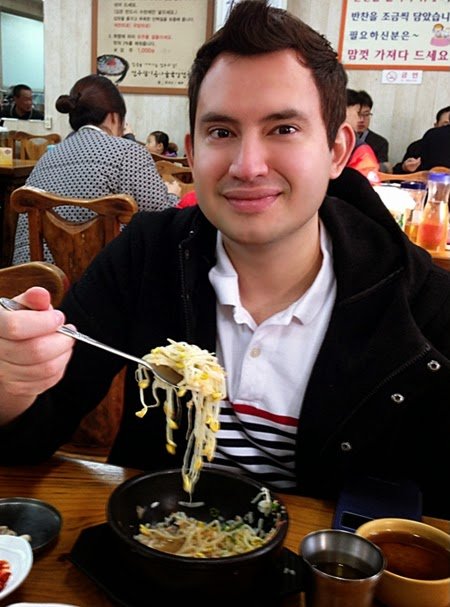
That's a photo of me trying Jeonju's specialty Kongnamul gukbab, which means bean sprout soup in English.
/ Traditional Kore- Photos by Elias Arturo Molina
Choco Pie at Poongnyeon Jegwa
The Choco Pie from Poongnyeon Jegwa, a bakery, is the most sought-after snack in Jeonju. People wait in long lines in front of the bakery just to buy the chocolate dessert. Bakers make over 5,000 Choco Pies daily, another testament to how popular the snack is.
Royal meal
Snacks such as Choco Pie and cane-shaped ice cream are just a small part of Jeonju's unique cuisine.
To get a real taste of Jeonju, visitors should eat at the "surasang," which translates to "meal for the king."
The table is filled with various types of side dishes that come with rice and soup. Some interesting side dishes are cooked vegetables called "namul," baked corvina called "jogi gui" and crab marinated in soy sauce called "ganjang gejang." Just be prepared for the generous servings.
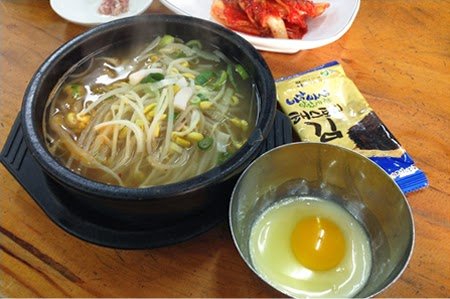
Kongnamul gukbab with suran, half-boiled egg served in a bowl with dried seaweed
Gyeonggijeon and Omokdae
Gyeonggijeon and Omokdae are major landmarks in the hanok village and are also must-see attractions in Jeonju.
There are no high-rise buildings in the hanok village, so visitors must climb a hill, Omokdae, to get a panoramic view of the village. The top of the hill has a pagoda in which climbers can rest.
Gyeonggijeon is another landmark in the hanok village and holds the only remaining portrait of King Yi Seong-gye, who established the Joseon Kingdom (1392-1910).
To enjoy this venue, visitors must simply walk along the peaceful bamboo forest and embrace the serenity. They can also walk with a guide to learn more about Gyeonggijeon.
A portrait of Yi is located at the main building after passing through three gates: the "hongsal-mun," "woesam-mun" and "naesam-mun." Gyeonggijeon is also the location for the TV drama "Gung" (Palace) starring Yoon Eun-hye and the period drama "Dragon's Tears," which was popular in the early 2000s.
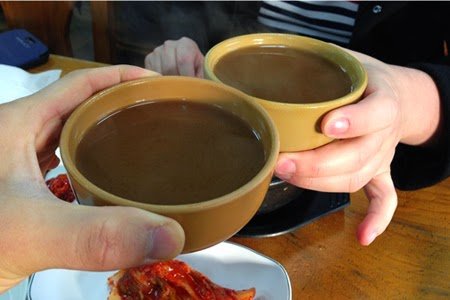
Drinking "moju," a beverage created by brewing eight herbal ingredients including ginger, dates and cinnamon with the "makgeolli" peasant
wine The ceiling of the hanok that I stayed in, left, and the interior of the room inside a hanok house represents the classic styles of Korean architecture.
Jeonju Hanji Museum
I took a taxi from Omokdae to the Hanji Museum, which is about 20 minutes away.
The museum is an excellent place to learn about the history and characteristics of hanji, a traditional Korean paper that can apparently last a thousand years.
There are many exhibition halls displaying a variety of goods made with the traditional paper. The museum also has a production hall where visitors can make their own hanji and write or draw on it with ink. This educational seminar is free.
Ending note
My trip to Jeonju was special. I experienced the beauty of traditional Korean culture and food, which until then I had only seen in books and photographs.
Jeonju is the place for those planning a quiet, relaxing trip to a good-hearted city. The city of your imagination is also not far away.
Travel tips
The Must-See Routes website (http://www.mustseeroutes.or.kr/en) by the
Visit Korea Committee is a good place to start when planning a trip to Jeonju
or other places in Korea. Traveling in North Jeolla Province can be confusing
for first-timers, so here are some suggested tour routes:
First day: Mt. Mai ¡æ Jinan Red Ginseng Spa - Jeonju Hanok Village - Makgeolli
town in Seosin-dong
Second day: Chaeseokgang - Naesosa - dolmen historic site in Gochang -
Gochang Eupseong (town castle)
Food: Jeonju Hanok Village - Gyeonggijeon - Makgeolli town in Seosin-dong
Traditional culture: Jeonju Hanji Museum - Jeonju Herbal Medicine Experience
Center - Jeonju Hanok Village
Elias Arturo Molina is 28 years old from Costa Rica.
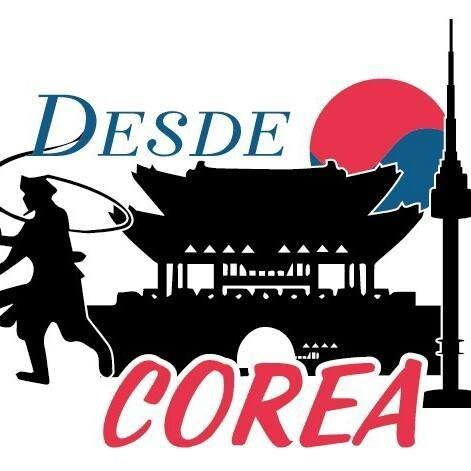
Congratulations @desdecorea! You have completed some achievement on Steemit and have been rewarded with new badge(s) :
Click on any badge to view your own Board of Honor on SteemitBoard.
For more information about SteemitBoard, click here
If you no longer want to receive notifications, reply to this comment with the word
STOP